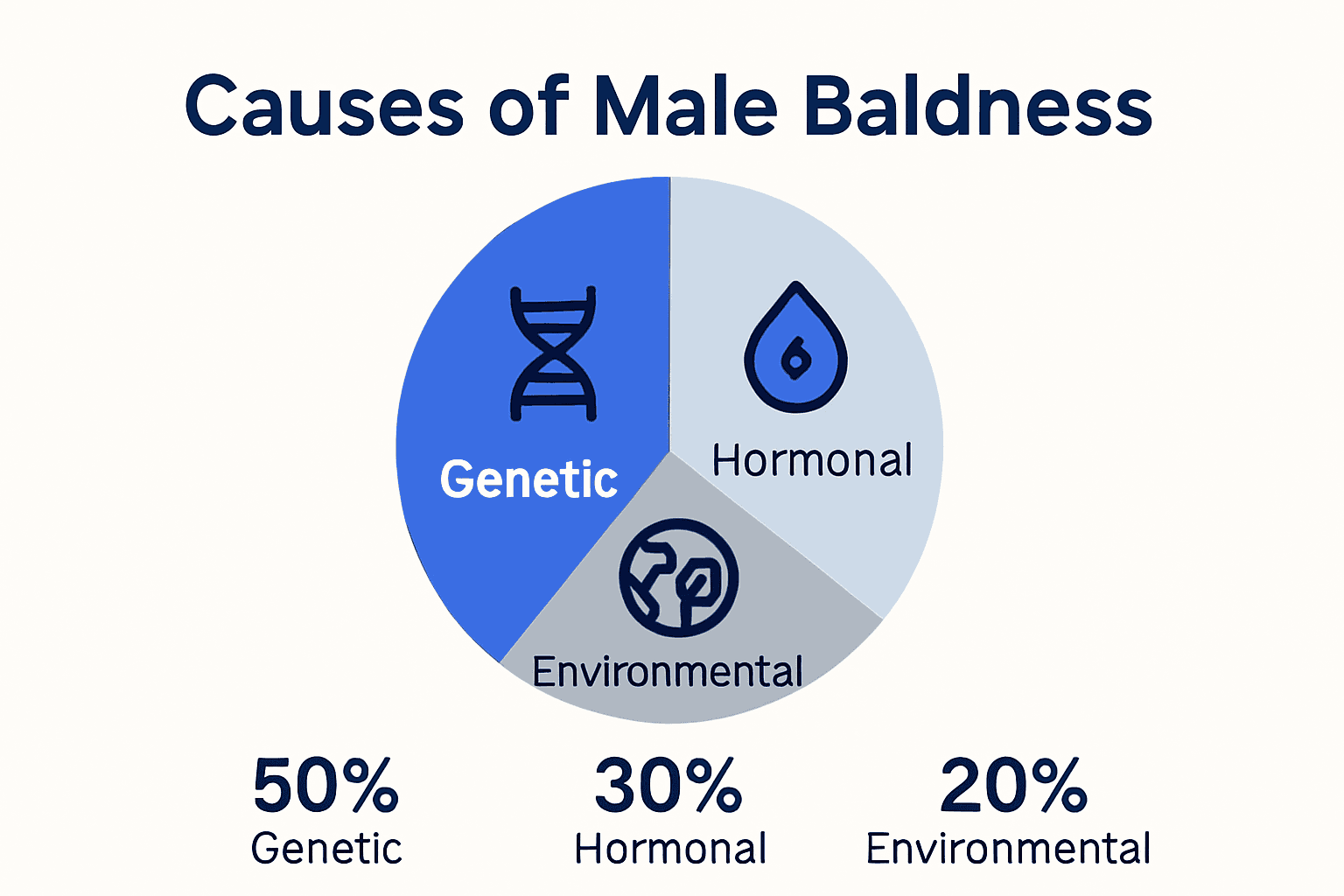Blog
Learning Materials
Male Baldness Treatment 2025: Best Solutions for Hair Growth
Updated: June 29, 2025

Male baldness will affect about half of all men by the time they hit 50. That sounds like a lost cause for full heads of hair. Here is the twist. The newest solutions for 2025 are breaking all the old rules with stem cell treatments, advanced robotic transplants and AI-guided care. It is suddenly possible to start reversing what genetics set in motion.
Table of Contents
- Understanding Causes Of Male Baldness
- Best Male Baldness Treatments For 2025
- Tracking Hair Growth Progress Effectively
- Personalized Hair Care And Professional Support
Quick Summary
| Takeaway | Explanation |
|---|---|
| Genetic and Hormonal Factors are Key | Approximately 50% of men experience significant hair loss by age 50, primarily due to genetic sensitivity to dihydrotestosterone (DHT), which leads to follicular miniaturization. |
| Innovative Treatments Are Evolving | 2025 presents advanced options such as finasteride, JAK inhibitors, stem cell therapy, and robotic transplantation, offering personalized and effective solutions for hair restoration. |
| Monitoring Progress Is Crucial | Utilizing digital trichoscopy and AI-powered applications allows men to track hair growth accurately, focusing on metrics like hair density, thickness, and overall scalp coverage. |
| Personalized Support Enhances Outcomes | Seeking professional consultation and utilizing customized treatment plans that incorporate lifestyle and holistic support can significantly improve hair health and recovery. |
Understanding Causes of Male Baldness
Male baldness is not simply a cosmetic concern but a complex biological process rooted in genetic and hormonal interactions. Understanding the underlying mechanisms helps men recognize and address hair loss more effectively.

Genetic Predisposition and Hormonal Influences
Genetic factors play a pivotal role in male pattern baldness, with approximately 50% of men experiencing significant hair loss by age 50. Research from the Hair Genetics Institute reveals that androgenetic alopecia is primarily determined by inherited sensitivity to dihydrotestosterone (DHT), a potent androgen hormone derived from testosterone.
The genetic blueprint for hair loss is established during early embryonic development, making some men more susceptible to follicular miniaturization. Specific genes inherited from both maternal and paternal lineages contribute to hair follicle sensitivity. When DHT binds to receptors in hair follicles, it triggers a progressive shrinking process that ultimately leads to hair thinning and eventual baldness.
Cellular Mechanisms of Hair Loss
At the microscopic level, hair loss involves complex cellular transformations. Scientific research from Cell Biology Quarterly demonstrates that specialized dermal papilla cells at the base of hair follicles are particularly vulnerable to hormonal changes. These cells control hair growth cycles and become progressively less effective with repeated DHT exposure.
The miniaturization process occurs gradually. Healthy hair follicles typically produce thick, robust hair strands. However, under DHT influence, these follicles begin producing progressively thinner and shorter hair until they eventually stop generating new hair altogether. This explains why male pattern baldness often starts with receding hairlines and gradually progresses to more extensive scalp areas.
Environmental and Stress Factors
While genetics predominantly determine male baldness, environmental factors can accelerate or exacerbate hair loss. Stress-related research from the Dermatological Sciences Institute indicates that conditions like telogen effluvium can trigger sudden hair shedding. Chronic stress, nutritional deficiencies, and certain medical treatments can disrupt normal hair growth cycles.
Factors such as poor nutrition, lack of sleep, excessive alcohol consumption, and smoking can compound genetic predispositions. These lifestyle elements potentially accelerate the hair loss process by creating suboptimal conditions for hair follicle health. Learn more about personalized hair health strategies that can help mitigate these environmental influences.
Understanding these intricate mechanisms empowers men to take proactive approaches toward managing hair loss. By recognizing the multifaceted nature of baldness, individuals can explore targeted treatments that address their specific genetic and environmental challenges.
Best Male Baldness Treatments for 2025
The landscape of male baldness treatments is rapidly evolving, with groundbreaking technologies and personalized approaches transforming hair restoration strategies in 2025. Men now have access to an unprecedented range of scientifically advanced solutions that address hair loss more effectively than ever before.
Pharmaceutical and Medical Interventions
Research from Medical Hair Restoration Institute indicates that finasteride remains the most prescribed treatment, with 66.4% of men utilizing this pharmaceutical intervention. However, 2025 introduces more sophisticated medical approaches. Emerging therapies like JAK inhibitors provide promising alternatives by targeting inflammatory pathways that contribute to hair loss.
Topical DHT blockers have become increasingly refined, offering more targeted and personalized treatments. These advanced formulations work at the molecular level to interrupt the hormonal processes responsible for follicular miniaturization. By combining precise pharmaceutical interventions with individualized genetic assessments, men can now access treatments specifically designed for their unique hair loss patterns.
Regenerative Medicine and Advanced Technologies
Market Research on Regenerative Hair Solutions predicts that stem cell therapy will constitute approximately 30% of hair loss treatments by 2025. This revolutionary approach harnesses the body's natural regenerative capabilities to stimulate hair follicle growth and repair. Techniques such as platelet-rich plasma (PRP) therapy and exosome injections represent cutting-edge interventions that promote cellular regeneration and improve hair density.
Robotic hair transplantation has also reached unprecedented levels of precision. Advanced robotic systems now enable surgeons to extract and transplant individual hair follicles with microscopic accuracy, minimizing scarring and maximizing natural-looking results. Check out our guide on advanced hair restoration techniques to understand how these technologies are transforming hair restoration.
Holistic and Personalized Treatment Approaches

Advanced Hair Restoration Technologies Report emphasizes the shift towards comprehensive, personalized treatment strategies. Modern approaches no longer view hair loss as a singular issue but as a complex interaction of genetic, environmental, and lifestyle factors. Integrated treatment plans now combine medical interventions, nutritional support, stress management, and advanced technological solutions.
Artificial intelligence and machine learning have revolutionized treatment personalization. By analyzing genetic markers, hormonal profiles, and individual hair loss patterns, clinicians can develop highly targeted interventions. Wearable technologies and smartphone applications now enable real-time monitoring of hair health, allowing for dynamic and responsive treatment adjustments.
The future of male baldness treatment in 2025 is characterized by precision, personalization, and a holistic understanding of hair health. Men experiencing hair loss now have more hope and more effective solutions than ever before.
Here is a summary table comparing the main male baldness treatment approaches mentioned, highlighting their key features and innovations in 2025.
| Treatment Approach | Key Features / Innovations | Usage / Prevalence (2025) |
|---|---|---|
| Pharmaceutical (e.g., Finasteride, DHT Blockers, JAK Inhibitors) | Targets hormonal/inflammatory pathways, highly personalized, molecular-level action | Finasteride: 66.4%, JAK rising |
| Regenerative Medicine (Stem Cells, PRP, Exosomes) | Stimulates follicle regeneration, uses body’s healing, minimal invasion | Stem cells: ~30% |
| Robotic Hair Transplantation | Microscopic precision, minimally invasive, natural results | Increasing adoption |
| Integrated & Personalized (AI/Genetic-Based Plans) | Combines interventions, uses AI & genetics, dynamic adjustments | Rapidly growing |
| Holistic/Lifestyle | Addresses nutrition, stress, supports medical treatments | Incorporated for all plans |
Tracking Hair Growth Progress Effectively
Effective tracking of hair growth is not just about observation but requires systematic and scientific approaches that provide comprehensive insights into hair restoration progress. Modern technologies and advanced methodologies now enable men to monitor their hair regrowth with unprecedented precision and detail.
Advanced Digital Monitoring Technologies
Research from Trichological Imaging Institute reveals that quantitative assessment methods have revolutionized hair growth tracking. Digital trichoscopy, a cutting-edge imaging technique, allows detailed microscopic analysis of scalp conditions, enabling men to visualize hair density, follicle health, and growth patterns with remarkable accuracy.
Smartphone applications and AI-powered scanning technologies have transformed personal hair tracking. These innovative tools use advanced algorithms to measure hair thickness, count individual follicles, and generate comparative reports over time. By capturing high-resolution images and applying machine learning analysis, users can obtain objective measurements of their hair restoration journey.
Clinical Assessment and Measurement Protocols
Stem Cell Research Protocols demonstrate sophisticated tracking methodologies used in clinical settings. Standardized assessment protocols, such as the 39-month follow-up studies conducted at Tokyo Medical University Hospital, provide comprehensive frameworks for evaluating hair regrowth interventions.
Key metrics for tracking hair growth include:
- Hair Density: Measuring the number of hair follicles per square centimeter
- Hair Thickness: Analyzing individual strand diameter
- Scalp Coverage: Quantifying visible hair distribution
- Growth Rate: Monitoring monthly hair length increases
The table below summarizes the main hair growth tracking metrics and their roles in monitoring progress.
| Metric | What It Measures | Role in Progress Tracking |
|---|---|---|
| Hair Density | Number of follicles per square centimeter | Assesses effect of treatment on coverage |
| Hair Thickness | Diameter of individual hair strands | Monitors hair strand strength & quality |
| Scalp Coverage | Visible distribution of hair on the scalp | Tracks overall improvement in appearance |
| Growth Rate | Monthly length increase of hair | Evaluates speed of regrowth |
Personalized Progress Documentation
Modern hair restoration strategies emphasize individualized tracking. Learn more about personalized hair health monitoring through comprehensive documentation techniques that go beyond traditional measurement methods. Professional dermatologists now recommend maintaining detailed digital portfolios that include:
- Monthly photographic documentation
- Detailed medical history logs
- Treatment response tracking
- Lifestyle and nutritional correlation analyses
Artificial intelligence now enables predictive modeling of potential hair restoration outcomes. By analyzing genetic markers, hormonal profiles, and individual treatment responses, these advanced systems can forecast expected hair growth trajectories with remarkable accuracy.
Tracking hair growth is no longer a passive process but an active, data-driven journey. Men can now take control of their hair restoration experience, armed with scientific tools and personalized insights that transform traditional approaches to understanding hair health.
Personalized Hair Care and Professional Support
Personalized hair care represents a transformative approach to addressing male baldness, moving beyond generic solutions toward comprehensive, individualized strategies that recognize each person's unique hair health journey. The integration of professional expertise with cutting-edge technologies now enables men to access unprecedented levels of tailored hair restoration support.
Professional Consultation and Diagnostic Approaches
Medical Hair Restoration Research indicates that 7.4% of male hair loss patients now seek specialized medical interventions, reflecting a growing trend toward expert-guided treatments. Professional trichologists and dermatology specialists employ advanced diagnostic techniques that go far beyond traditional assessments. These comprehensive evaluations include genetic screening, hormonal profiling, and detailed scalp microbiome analysis to develop truly personalized treatment protocols.
Modern diagnostic approaches consider multiple interconnected factors. Specialists now examine not just hair follicle health but also evaluate lifestyle elements such as stress levels, nutritional intake, sleep patterns, and environmental exposures that might contribute to hair loss. This holistic methodology ensures that treatment recommendations address root causes rather than merely managing surface-level symptoms.
Customized Treatment Integration
Innovative Hair Solutions Report highlights the emergence of seamlessly integrated hair restoration solutions. Professional support now extends beyond medical interventions to include personalized styling strategies, custom hairpiece design, and comprehensive long-term management plans. Advanced specialists can now create custom hairpieces that blend imperceptibly with existing hair, offering natural-looking results that can be washed, styled, and maintained like natural hair.
Technology plays a crucial role in personalizing hair care approaches. Three-dimensional scalp mapping, AI-driven predictive modeling, and real-time follicle tracking enable professionals to design dynamic treatment plans that adapt to an individual's changing hair health landscape. Explore our guide to comprehensive hair care strategies to understand how these personalized approaches work.
Lifestyle and Holistic Support
Modern Men's Hair Care Trends demonstrate a significant shift toward holistic, lifestyle-integrated hair care solutions. Professional support now encompasses nutrition counseling, stress management techniques, and personalized supplement recommendations that complement medical treatments.
Support groups and digital platforms have also evolved, providing men with comprehensive resources beyond traditional medical consultations. These platforms offer peer support, psychological counseling, and continuous education about hair health management. By addressing the emotional and psychological dimensions of hair loss, these support systems recognize that effective treatment extends far beyond physical interventions.
Personalized hair care in 2025 represents a sophisticated, multidimensional approach that empowers men to take control of their hair health. By combining advanced medical expertise, cutting-edge technologies, and comprehensive support systems, individuals can now access truly transformative hair restoration strategies tailored precisely to their unique needs.
Frequently Asked Questions
What are the main causes of male baldness?
Male baldness primarily results from genetic predisposition and hormonal influences, especially sensitivity to dihydrotestosterone (DHT). Environmental stress factors and lifestyle choices can also accelerate hair loss.
What treatments are available for male baldness in 2025?
In 2025, effective treatments for male baldness include pharmaceutical options like finasteride and JAK inhibitors, regenerative therapies such as stem cell therapy, robotic hair transplantation, and personalized holistic approaches incorporating lifestyle changes.
How can I track my hair growth progress effectively?
You can track hair growth effectively using advanced digital monitoring technologies, such as digital trichoscopy and AI-powered apps, that measure hair density, thickness, and scalp coverage. Regular clinical assessments and personalized documentation can also enhance tracking.
Why is personalized care important for hair restoration?
Personalized care enhances hair restoration outcomes by addressing individual genetic, hormonal, and lifestyle factors. Professional consultations and customized treatment plans lead to more effective and targeted interventions tailored to your specific hair health needs.
Tired of Guesswork in Your Hair Recovery Journey?
You have just learned how the future of male baldness treatments is personalized, data-driven, and full of hope. But sorting through complex options like DHT blockers, robotic transplants, and stem cell therapy can leave you wondering which solution really fits your unique pattern of hair loss. The pain of watching your hair thin and not knowing which approach will truly work is real.

Take control today. Connect your real-world progress to personalized insights with MyHair.ai — the platform that uses AI analysis to scan, track, and recommend solutions tailored just for you. Join a community of men who are turning scientific breakthroughs into real results. Upload your own scan, get smart recommendations, and watch your journey unfold with confidence. Start your personalized hair growth assessment now at MyHair.ai and don't let another month pass you by.
Recommended Articles
- Top Hair Thinning Problem Solutions for 2025: Expert Tips | MyHair
- Natural Hair Growth Routine 2025: Proven Steps for Fast Results | MyHair
- Best Natural Treatment for Receding Hairline in 2025: Safe & Effective Solutions | MyHair
- Best Proven Methods for Thick Hair Growth in 2025 | MyHair
- Good Natural Hair Products for Growth and Hair Loss (2025) | MyHair
- How to Fix a Bald Spot on Crown of Head: 2025 Hair Growth Guide | MyHair